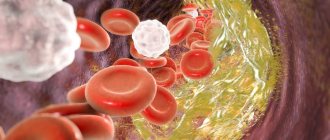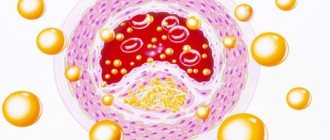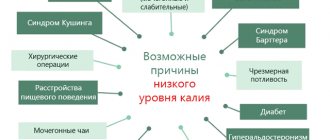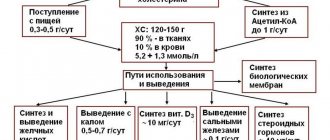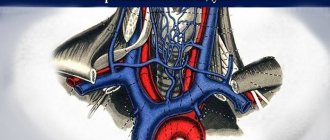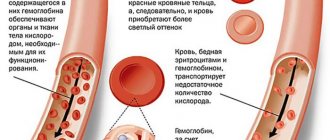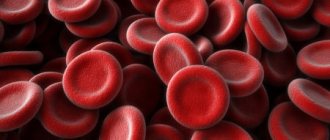What are electrolytes?
Electrolytes occupy an important place in the biochemical analysis of blood
Electrolytes in the blood are positively or negatively contaminated particles formed during the breakdown of salts, acids and alkalis in the blood during natural physiological processes. The main electrolytes in humans are:
- magnesium,
- potassium,
- iron,
- sodium,
- calcium,
- chlorine,
- phosphorus.
Particles are present in blood plasma and are involved in most processes occurring in human tissues and organs. There are many reasons for electrolyte imbalance. Some of them are associated with serious pathologies, which is why, if deviations are detected during analysis, an examination is required.
Natural loss
A person loses a percentage of electrolytes every day through sweat. The process of loss is normal. If a person plays sports, he loses much more essential substances. It is advisable to provide the body with sufficient amounts of magnesium and potassium salts to prevent dehydration.
It is the loss of electrolytes that is a dangerous pathological condition and the main cause of symptoms of dehydration. During heavy physical activity, use special water enriched with the main electrolytes: potassium, magnesium and chlorine.
It is also advisable to increase the consumption of food that is rich in one or another element. It is worth understanding that this should only be done when playing sports or similar activities. There is no need to simply increase the consumption of food containing magnesium, chlorine or potassium.
What happens when you lose?
When electrolytes are lost naturally, general weakness and decreased performance occur. It is very difficult to bring the body to complete exhaustion, so dangerous pathologies do not arise. To fully recover, it is enough to consume a special drink or food containing nutrients and electrolytes.
General weakness
Do not constantly disturb the water-electrolyte balance. During a lack of electrolytes, many organs suffer. There is a possibility of wear due to a lack of necessary substances. Only a professional athlete, under the supervision of a sports physician, performs large volumes of exhausting training without consequences. If a person’s main goal when playing sports is to maintain health, he should follow the principle of not training to failure.
An ordinary person should also strive to maintain an ideal water and electrolyte balance. In this state, each organ works efficiently and without wear. When each element is within normal limits, the person is considered to be in good health. Not all people have the correct balance of salts in their body. To achieve the norm, you will need to adjust your diet and add more active activities to your life.
Functions and role of electrolytes
One of the functions of electrolytes is to ensure impulse transmission
Electrolytes are present in the blood and intercellular space, entering it through cell membranes. The particles normalize the transfer of fluid from the blood to the cells of tissues and organs, and also maintain the correct acidity in the blood and ensure the full passage of nerve impulses.
Depending on the element, electrolytes perform different functions. Thus, they help maintain proper functioning of the heart muscle, bone formation, blood clotting, and metabolic processes. Deviations from the norm have a negative impact on the entire body.
Sodium
Sodium is the main extracellular cation, an element that helps the body actively grow and develop. It ensures the transport of nutrients to the cells of the body, participates in the generation of nerve impulses, has an antispasmodic effect, activates digestive enzymes and regulates metabolic processes.
The norm of sodium in the blood for adults is 135 – 150 mmol/l. (For children – 130 – 145 mmol/l).
Sodium leaves the body through sweating. People constantly need it, especially those who experience severe physical activity. You need to constantly replenish your sodium supply. The daily sodium intake is about 550 mg. Plant and animal sources of sodium: table salt, cereals, soy sauce, vegetables, beans, organ meats, seafood, milk, eggs, pickles, sauerkraut.
When the amount of sodium cations in the blood changes, the functioning of the kidneys, nervous system, and blood circulation is disrupted.
A blood test for sodium electrolytes is carried out for gastrointestinal dysfunction, diseases of the excretory system, and endocrine pathologies.
Hypernatremia (increased levels of the element in the blood) develops when:
- Excess salt in the diet,
- Long-term hormone therapy
- Pituitary hyperplasia,
- Adrenal tumors,
- Comatose state
- Endocrinopathies.
The causes of hyponatremia are:
- Refusal of salty foods,
- Dehydration resulting from repeated vomiting or prolonged diarrhea
- Hyperthermia,
- Loading doses of diuretics,
- Hyperglycemia,
- Hyperhidrosis,
- Prolonged shortness of breath
- Hypothyroidism,
- nephrotic syndrome,
- Heart and kidney diseases,
- Polyuria,
- Cirrhosis of the liver.
Hyponatremia is manifested by nausea, vomiting, decreased appetite, palpitations, hypotension, and mental disorders.
Indications for electrolyte analysis
Heart rhythm disturbances - indication for analysis
A blood test for the volume of electrolytes is carried out according to medical indications. The main reasons for the study are:
- examination to diagnose a disease when the patient has dizziness, behavioral disturbances, and nausea;
- arrhythmias;
- comprehensive measures for diagnosing liver and pancreas diseases;
- determination of the most effective drugs for a particular patient with hypertension.
Also, the analysis can be prescribed according to medical prescriptions for pregnant women and people suffering from chronic pathologies of the gastrointestinal tract and heart.
Calcium
Calcium is an electrolyte responsible for the normal functioning of the coagulation and cardiovascular systems, regulation of metabolism, strengthening the nervous system, building and ensuring the strength of bone tissue, and maintaining a stable heart rhythm.
The normal level of calcium in the blood is 2-2.8 mmol/l. Its content does not depend on age and gender characteristics. Determination of calcium in the blood must be carried out in case of rarefaction of bone tissue, bone pain, myalgia, diseases of the gastrointestinal tract, heart, blood vessels, and oncopathology.
Hypercalcemia develops when:
- Hyperfunction of the parathyroid glands,
- Cancerous destruction of bones,
- Thyrotoxicosis,
- Tuberculous inflammation of the spine,
- Kidney pathologies,
- Gout,
- Hyperinsulinemia,
- Excessive intake of vitamin D into the body.
The causes of hypocalcemia are:
- Bone formation disorders in children,
- Bone loss,
- Lack of thyroid hormones in the blood,
- Inflammatory and degenerative processes in the pancreas,
- Magnesium deficiency
- Violation of the bile excretion process,
- Liver and kidney dysfunction,
- Long-term use of cytostatics and antiepileptic drugs,
- Cachexia.
The following foods are sources of calcium: milk, white beans, canned tuna, sardines, dried figs, cabbage, almonds, oranges, sesame seeds, seaweed. Sorrel, chocolate, spinach are foods with an antagonistic effect that suppress the effect of calcium. This microelement is absorbed only in the presence of an optimal amount of vitamin D.
Preparing for the study
The study is carried out on an empty stomach
Preparation for analysis allows you to obtain the most accurate research result. The main points in it are:
- refusal to eat 12 hours before blood donation;
- You can drink only clean water without gas in the morning before the analysis;
- exclusion of physical and emotional stress the day before the analysis;
- quit smoking 2 hours before the test.
When taking medications, the doctor must be warned about this so that the specialist, when interpreting the results, can make adjustments for the effect of the drugs.
How to replenish the water-salt balance with the help of medications?
Water and electrolyte imbalance manifests itself differently in everyone, so the approach to “treatment” must be individual. It is extremely rare that the body lacks all elements at once, so after passing the diagnosis, the specialist prescribes a specific medicine to the patient.
Despite the abundance of choice of dietary supplements in pharmacies and the fact that they are all available without a prescription, you should not self-medicate. I would like to remind you that excess salts in the body leads to the development of various diseases. Don't forget about the side effects.
In addition, in addition to the salts themselves, it is necessary to select preparations for better absorption and accumulation of these elements in the body.
Methods for determining the amount of electrolytes
Electrolyte levels are determined using a biochemical blood test. One of two methods can be used.
- Weight. It is based on carrying out certain chemical reactions in which blood serum is used. As a result of these actions, a precipitate is obtained that does not dissolve in water. It is weighed on special scales. Next, the indicator is calculated using the formula.
- Photoelectrocalorimetry. With this method, the color result of the reaction with blood plasma is obtained. The intensity of the color determines the amount of electrolytes.
The determination method used in a particular laboratory depends on its equipment.
Getting rid of deficit
How to restore electrolytes in the body? There are 2 ways: natural and medicinal. The natural method has already been discussed. This method is preferable because a person becomes more attentive and disciplined and follows the correct diet constantly.
Sometimes only one electrolyte may be lacking, so it is better to get tested for electrolytes before dieting. Then it will become clear how to act and how to increase electrolytes in the body. Pharmacies offer a wide selection of multivitamins with minerals in convenient forms. They are applicable in case of severe deficits or unwillingness to go on a limited diet. In addition, drinking electrolytes are available in tablets, granules and powders (Orsol, Torrox, Nutrisal). They are simply diluted with water. For the most part, they are considered elements of sports nutrition, because it is during training that salts are lost through sweat. But drinking electrolytes are also used for dehydration – for example, “Regidron”.
Electrolyte standards for adults and children
The norm of components in the blood is different in children and adults. So, their main electrolytes have the following indicators.
| Iron | Phosphorus | Potassium | |
| Children | 7-18 mmol/l | 1.19-2.78 mmol/l | 3.5-5.5 mmol/l |
| Adults | 17.9-22.5 mmol/l | 1.87-1.45 mmol/l | 3.4-5.5 mmol/l |
Deviation of the indicator from these norms is a violation and harms the body. When deciphering the analysis result, an individual approach is important, as this allows us to take into account the characteristics of a particular patient.
Why do you need chlorine?
Chlorine controls the acid-base composition of the blood, maintains the desired concentration of substances in body fluids, participates in digestion, and helps liver cells.
The maximum content is in olives, ordinary table salt.
The standard does not depend on age and gender: from 98 to 107 mmol/l.
Chlorine levels increase when:
- alkalization of blood;
- renal failure;
- increased activity of the adrenal cortex;
- diabetes insipidus.
Chlorine deficiency is determined by:
- a significant increase in fluid intake;
- vomiting and increased sweating;
- overdose of diuretics;
- traumatic brain injury;
- state of acidosis (coma).
Deficiency is manifested by significant hair and tooth loss.
Reduced electrolyte levels: causes
Heart disease can cause electrolyte imbalance
A drop in electrolyte levels is also quite common. This disorder can be provoked by physical overload, nervous tension, alcohol and coffee abuse, as well as poor nutrition. The disorder can also develop against the background of liver pathologies, intestinal dysfunction, heart disease, and kidney disease.
Prevention is the key to health
It is necessary to constantly maintain the balance of salts and fluids in the body, and not resort to replenishing it only when you already feel unwell.
For prevention, engage in light physical activity, monitor proper nutrition and periodically undergo examination by specialists (if there is a slight deviation from the norm, you can resort to medication). For maximum results, you will have to maintain a healthy lifestyle on an ongoing basis.
Stop torturing yourself!
- We will develop a personal nutrition program for you.
- With it you will achieve your ideal weight without fasting or physical activity.
- This is the only truly healthy and natural way to lose weight.
